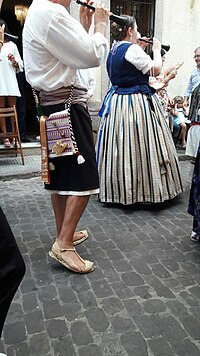Dulzaina
The instrument is deeply rooted in the folklore of Burgos, Segovia, Soria, in some areas of Ávila, Madrid, Guadalajara, Toledo, Cuenca, León and Salamanca, less extended in the Basque Autonomous Community and widely used in Navarre and La Rioja.
G-dolçaina (dolçaina en sol) is a transposing instrument and its music is written in treble clef.
In order to find the actual concert note pitches (in C) in a score for dolçaina, one must transpose them up a perfect fifth, as for the cor anglais (English horn).
Unless specifically stated otherwise, in the following sections, when there is a reference to notes or keys, one must think on the ones that are used by dolçaina players (in G) and not to the actual pitch (in C).
Historically, the dolçaina has played a main role in big gatherings of people during Valencian festivities and traditions, so it is unsurprising that its powerful sound has been specially valued and developed.
Even though the dolçaina produces a high-pitched sound range, it has a great timbric identity thanks to its richness in harmonics.
Even though the dolçaina was not originally intended to produce chromaticisms, they can be achieved through a very complex and difficult technique, with obvious timbre and volume differences.
Thanks to modern interpretation techniques, effects of dynamics can be achieved by varying the air pressure and making subtle changes in the embouchure.
As opposed to other instruments, decreasing volume level while playing dolçaina implies a huge physical effort in the embouchure and a very difficult and complex technique.
This and other technical issues such as the impossibility of executing double or triple staccato force the player to play slower.
In order to play in faster tempos, the musician has to resort to combinations of slurrings, keeping in mind the difficulty implied by the change of octave, where there is a big break in-between the register, and in many instances it is more or less impossible to maintain an even tone.
In spite of these circumstances, techniques for simple attacks and slurs are evolving at a great pace in order to achieve a wider range of nuances in phrasing.
However, at a certain pace, it is complicated to play F natural, Bb/A# and Ab/G# due to their fingering positions, like the recorder (a technique known as cross-fingering).
The reason for this lies with some of its features: Being a short-length instrument, it offers little resistance to air flow and therefore requires great pressure and a strong airflow.
The reed used on the dolçaina is among the biggest and most resistant in the oboe family, meaning that great pressure must be applied so as to manipulate the sound.
However, endurance may increase progressively if the piece features fewer high-pitched notes, more breaths, empty bars and less dynamics.


